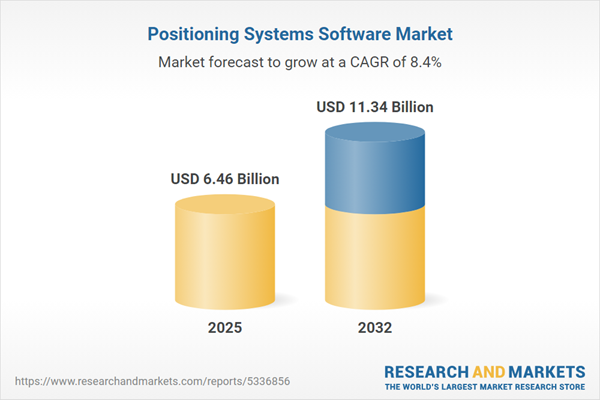Speak directly to the analyst to clarify any post sales queries you may have.
The positioning systems software market is evolving rapidly due to technological innovations and expanding cross-industry applications. Senior leaders must navigate this complex landscape to stay competitive, foster operational improvements, and drive value in the face of dynamic trends.
Market Snapshot: Positioning Systems Software Market Size and Growth
The positioning systems software market grew from USD 5.96 billion in 2024 to USD 6.46 billion in 2025, progressing with a CAGR of 8.36% and projected to reach USD 11.34 billion by 2032. This growth underscores significant enterprise investment in location intelligence solutions across sectors including aerospace, automotive, logistics, and agriculture.
Scope & Segmentation
This market intelligence report delivers segmented insights and development analysis on positioning systems software:
- Technology: GNSS (BeiDou, Galileo, Glonass, GPS), Inertial Navigation Systems, Sensor Fusion
- Precision Level: High Precision/Sub-Meter Accuracy, Ultra-Precision, Standard Accuracy
- Application: Aerospace and Defense, Agriculture, Automotive, Consumer Electronics, Logistics and Transportation, Maritime, Surveying and Mapping
- Deployment Type: Cloud Based, On Premises
- End User: Commercial/Enterprise Users, Government & Defense, Individual Consumers, Research & Academia
- Regions: Americas (North America: United States, Canada, Mexico; Latin America: Brazil, Argentina, Chile, Colombia, Peru), Europe, Middle East & Africa (Europe: United Kingdom, Germany, France, Russia, Italy, Spain, Netherlands, Sweden, Poland, Switzerland; Middle East: United Arab Emirates, Saudi Arabia, Qatar, Turkey, Israel; Africa: South Africa, Nigeria, Egypt, Kenya), Asia-Pacific (China, India, Japan, Australia, South Korea, Indonesia, Thailand, Malaysia, Singapore, Taiwan)
- Leading Companies: Trimble Inc., Hexagon AB, Topcon Corporation, TomTom N.V., Leica Geosystems AG, Zebra Technologies Corporation, Cisco Systems, Inc., Juniper Networks, Inc., Ubisense Group plc
Key Takeaways for Senior Decision-Makers
- Market expansion is fueled by the convergence of satellite navigation, inertial sensing, and real-time data analytics, elevating enterprise agility and operational intelligence.
- Integrated machine learning in positioning systems software delivers enhanced signal reliability and mitigates external interference, empowering advanced automation and situational awareness.
- Cloud-based and hybrid deployments ensure scalable, globally accessible geospatial services, while on-premises solutions remain viable for sensitive and compliance-critical uses.
- Security, data integrity, and resilience to spoofing threats require rigorous measures, prompting fresh investment in blockchain and distributed trust architectures.
- Standardization across hardware and software interfaces is essential to unlock widespread adoption and ensure interoperability between diverse platform vendors.
- Regional growth patterns indicate varied technology adoption, with digital transformation accelerating uptake in Asia-Pacific, and infrastructure innovation guiding uptake in Europe, the Middle East, and Africa.
Tariff Impact: Navigating Supply Chain Disruptions and Innovation Shifts
The 2025 United States tariff adjustments add complexity for the positioning systems software ecosystem, impacting sourcing strategies and component acquisition costs. Enterprises are increasingly evaluating alternative manufacturing hubs, deepening ties with domestic supply chains, and localizing firmware to adapt to shifting trade regulations. Strategic collaborations with regional system integrators help offset costs, deliver bundled services, and maintain steady innovation output during periods of geopolitical volatility.
Methodology & Data Sources
Insights derive from thorough secondary research of technical literature and regulatory filings, supplemented by structured interviews with industry experts, system integrators, and senior executives. Quantitative and qualitative data were validated through an iterative peer-review process, ensuring objectivity and reliability throughout the analysis.
Why This Report Matters
- Guides strategic planning by clarifying technological trends and adoption barriers across major verticals and geographies.
- Equips stakeholders with actionable intelligence for navigating regulatory, supply chain, and security challenges.
- Enables effective market entry, partnership, and innovation decisions by profiling current leaders and emerging competitors in depth.
Conclusion
This report equips senior decision-makers with an actionable, strategic overview of the positioning systems software market. Leverage the insights provided to anticipate shifts, refine operational strategies, and unlock new growth opportunities in global geospatial intelligence.
Additional Product Information:
- Purchase of this report includes 1 year online access with quarterly updates.
- This report can be updated on request. Please contact our Customer Experience team using the Ask a Question widget on our website.
Table of Contents
3. Executive Summary
4. Market Overview
7. Cumulative Impact of Artificial Intelligence 2025
Companies Mentioned
The companies profiled in this Positioning Systems Software market report include:- Trimble Inc.
- Hexagon AB
- Topcon Corporation
- Topcon
- TomTom N.V.
- Leica Geosystems AG
- Zebra Technologies Corporation
- Cisco Systems, Inc.
- Juniper Networks, Inc.
- Ubisense Group plc
Table Information
| Report Attribute | Details |
|---|---|
| No. of Pages | 187 |
| Published | October 2025 |
| Forecast Period | 2025 - 2032 |
| Estimated Market Value ( USD | $ 6.46 Billion |
| Forecasted Market Value ( USD | $ 11.34 Billion |
| Compound Annual Growth Rate | 8.3% |
| Regions Covered | Global |
| No. of Companies Mentioned | 11 |









